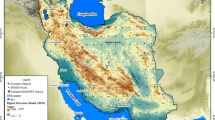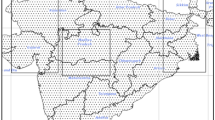Abstract
Using the Total Ozone Mapping Spectrometer (TOMS) data from the National Aeronautics and Space Administration (NASA) earth satellites, the Aerosol Optical Depth (AOD) as indicated by AOD Index (AI) for the period 1978–2005 is analyzed for northern China. The spatial distribution of annual mean AI has the largest values in the desert regions of northwestern China, such as southern Xinjiang Taklimakan Basin, western Gansu and Qinghai’s Qaidam Basin. Large values are found in western Inner Mongolia, the Jogger Basin, and north of the Loess Plateau, as well as in the North China and Northeast China Plains. In Northern China, the AI of spring and summer is larger than in other seasons. The large AI values in spring register the most extensive coverage, but the AI values in regions affected by the Asian monsoon experience a significant decrease during the summer season. The lowest AI values generally occur in autumn in North and Northeast China, but they appear in winter in the northwestern arid region. Overall, the analysis results using TOMS AI data well reflect the spatiotemporal characteristics of dust aerosol as reported previously based on the dust weather observation data, with greater consistency seen in northwestern arid and semi-arid regions. It is also realized that the TOMS AI data are potentially useful for estimating atmospheric mineral aerosol deposition flux in northern China in order to better understand the formation and evolution of China loess in the Quaternary.







Similar content being viewed by others
References
Bond TC, Streets DG, Yarber KF, Nelson SM, Woo JH, Klimont Z (2004) A technology-based global inventory of black and organic carbon emissions from combustion. J Geophys Res-Atmos 109(D14)
Chu DA, Kaufman YJ, Ichoku C, Remer LA, Tanré D, Holben BN (2002) Validation of MODIS aerosol optical depth retrieval over land. Geophys Res Lett 29(12)
Deng ZQ, Han YX, Bai HZ, Zhao TL (2009) Analysis of the causes for change of dust aerosol concentration in desert regions. China Envi Sci 29(12):1233–1238
Ding K, Liu JP (2011) Spatial distribution and dynamic changes of sand storm in northern China in recent 50 years. J Arid Land Resour Envi 25(4):116–120
Ding ZL, Sun JM, Liu TS (1999) Sedimentological indices as indicators of the relationship between deserts and Loess. Sci China 29(1):82–87
Fang ZY, Wang W (2006) Characteristics of China dust storm in 2002. J Appl Meteor Sci 14(5):513–522
Fang ZY, Zhang YG, Zheng XJ, Cao YC (2001) The method for monitoring dust devil using satellite and preliminary results [J]. Quate Sci 1:006
Fang XM, Han YX, Ma JH, Song LC, Yang SL, Zhang XY (2003) Dust characteristics and loess deposition over the Qinghai-Tibetan plateau. Chin Sci Bull 49(11):1084–1090
Gao ZT, Zhang RJ, Su LX (2009) Characteristic analysis of atmospheric black carbon aerosols in Changchun in autumn and winter. Plateau Meteorol 28(4):803–807
Ke F, Hui-Jun W (2006) Interannual variability of dust weather frequency in Beijing and its global atmospheric circulation. Chin J Geophysics-Chinese Edition (in Chinese) 49(4):1006–1014
Levy RC, Remer LA, Dubovik O (2007) Global aerosol optical properties and application to moderate resolution imaging spectroradiometer aerosol retrieval over land. J Geophys Res-Atmos 112(D13)
Li C, Mao J, Lau KHA, Chen JC, Yuan Z, Liu X et al (2003) Characteristics of distribution and seasonal variation of aerosol optical depth in eastern China with MODIS products. Chin Sci Bull 48(22):2488–2495
Li SY, Lei JQ, Xu XW, Wang D, Wang LH, Li YD (2006) Features of sandstorms in hinterland of Taklimakan Desert a case of Tazhong area. Ziran Zaihai Xuebao/ J Nat Dis 15(2):14–19
Li X, Wang S, Duan L, Hao J, Li C, Chen Y, Yang L (2007) Particulate and trace gas emissions from open burning of wheat straw and corn Stover in China. Environ Sci Technol 41(17):6052–6058
Li JC, Dong ZB, Wang XM (2008) Amount of spring dustfall and its environmental significance in east part of northern China. J Desert Res 28(2):195–201
Lin II, Chen JP, Wong GT, Huang CW, Lien CC (2007) Aerosol input to the South China Sea: results from the MODerate resolution imaging spectro-radiometer, the quick scatterometer, and the measurements of pollution in the troposphere sensor. Deep-Sea Res II Top Stud Oceanogr 54(14):1589–1601
Liu DS (1985). Loess and environment in China. Beijing: Science Press. (in Chinese)
Liu D, Ding Z, Guo Z (1991) Loess, environment, and global change. Science Pr.
Liu LY, Shi PJ, Gao SY, Zou XY, Erdon H, Yan P, Zhang CL (2004) Dustfall in China’s western loess plateau as influenced by dust storm and haze events. Atmos Environ 38(12):1699–1703
Liu Y, Sun L, Zhou X, Luo Y, Huang W, Yang C, Wang Y, Huang T (2014) A 1400-year terrigenous dust record on a coral island in South China Sea. Sci Report 2014. doi:10.1038/srep04994
Lu Z, Zhang Q, Streets DG (2011) Sulfur dioxide and primary carbonaceous aerosol emissions in China and India, 1996–2010. Atmos Chem Phys 11(18):9839–9864
Martonchik JV, Diner DJ, Crean KA, Bull MA (2002) Regional aerosol retrieval results from MISR. IEEE Trans Geosci Remote Sens 40(7):1520–1531
McTainsh GH, Nickling WG, Lynch AW (1997) Dust deposition and particle size in Mali, West Africa. Catena 29(3):307–322
Mi W, Li Z, Xia X, Holben B, Levy R, Zhao F, Cribb M (2007) Evaluation of the moderate resolution imaging spectroradiometer aerosol products at two aerosol robotic network stations in China. J Geophys Res Atmos 112:D22S08
Nihlén T, Mattsson JO, Rapp A, Gagaoudaki C, Kornaros G, Papageorgiou J (1995) Monitoring of Saharan dust fallout on Crete and its contribution to soil formation. Tellus B 47(3):365–374
Novakov, T., & Penner, J. E. (1993). Large contribution of organic aerosols to cloud-condensation-nuclei concentrations.
Pye K (2015) Aeolian dust and dust deposits. Elsevier
Pye K, Zhou LP (1989) Late Pleistocene and Holocene aeolian dust deposition in North China and the Northwest Pacific Ocean. Palaeogeogr Palaeoclimatol Palaeoecol 73(1):11–23
Qian ZA, Shong MH, Li WY (2002) Analyses on distributive variation and forecast of sand-dust storms in recent 50 years in North China. J Desert Res 2:106–111
Qian ZA, Cai Y, Liu JT, Li DL, Liu ZM, Song MH (2004) Some advances in dust storm researches in northern China. J Arid Land Resour Envi 18(1):1–8
Qin X, Cai B, Liu T (2005) Loess record of the aerodynamic environment in the East Asia monsoon area since 60,000 years before present. J Geophys Res Solid Earth 110(B1)
Qiu XF, Zeng Y, Miao QL (2001) Temporal-spatial distribution as well as tracks and source areas of sand-dust storms in China. Acta Geogr Sin (Chin Ed) 56(3):322–330
Ren, G.Y., Guo, J., Xu, M.Z., Chu, Z.Y., Zhang, L., Zou, X.K., & Liu X.N, L. (2005). Climate changes of China’s mainland over the past half century. Acta Meteorol Sin, 63(6), 942–956.
Ren XY, Ren GY, Wei MJ (2014) Comparison between TOMS optical depth index of aerosol and dust weather frequency in northern China. Arid Zone Res (in Chin) 31(5):874–881
Seinfeld JH, Pandis SN (2016) Atmospheric chemistry and physics: from air pollution to climate change. John Wiley & Sons
Streets DG, Gupta S, Waldhoff ST, Wang MQ, Bond TC, Yiyun B (2001) Black carbon emissions in China. Atmos Environ 35(25):4281–4296
Streets DG, Yu C, Wu Y, Chin M, Zhao Z, Hayasaka T, Shi G (2008) Aerosol trends over China, 1980–2000. Atmos Res 88(2):174–182
Sun J, Zhang M, Liu T (2001) Spatial and temporal characteristics of dust storms in China and its surrounding regions, 1960–1999: relations to source area and climate. J Geophys Res-Atmos 106(D10):10325–10333
Sun DH, Lu HY, Sun YB (2007) Grain-size and dust accumulation rate of late Cenozoic Aeolian deposits and the inferred atmospheric circulation evolutions. Quat Sci 27(2):251–262
Torres O, Bhartia PK, Herman JR, Ahmad Z, Gleason J (1998) Derivation of aerosol properties from satellite measurements of backscattered ultraviolet radiation: theoretical basis. J Geophys Res-Atmos 103(D14):17099–17110
Torres O, Bhartia PK, Herman JR, Sinyuk A, Ginoux P, Holben B (2002) A long-term record of aerosol optical depth from TOMS observations and comparison to AERONET measurements. J Atmos Sci 59(3):398–413
Wang ZH (2003) The research on the aerolion dust deposition monitoring. J Arid Lnad Resour Envi (in Chin) 17(1):54–59
Wang, J.G., & Ren, G.Y., (2003). Atlas of dust climate in China. Meteorological Press (in Chinese), Beijing.
Wang SG, Dong GR, Yang DB, Jin J, Shang KZ (1996) A study on sand-dust storms over the desert region in North China. J Nat Dis 5(2):86–94
Wang SG, Dong GG, Chen HZ, Li XL, Jin J (2000) Advances in studies of sand-dust storms of China. J Desert Res (in Chin) 20(4):349–356
Wang Z, Wang T, Gao R, Xue L, Guo J, Zhou Y, Zhou X (2011) Source and variation of carbonaceous aerosols at mount tai, North China: results from a semi-continuous instrument. Atmos Environ 45(9):1655–1667
Wang Z, Wang T, Guo J, Gao R, Xue L, Zhang J, Wang W (2012) Formation of secondary organic carbon and cloud impact on carbonaceous aerosols at mount tai, North China. Atmos Environ 46:516–527
Washington R, Todd M, Middleton NJ, Goudie AS (2003) Dust-storm source areas determined by the total ozone monitoring spectrometer and surface observations. Ann Assoc Am Geogr 93(2):297–313
Wu Y, Zhang R, Han Z, Zeng Z (2010) Relationship between east Asian monsoon and dust weather frequency over Beijing. Adv Atmos Sci 27:1389–1398
Xu J, Bergin MH, Yu X, Liu G, Zhao J, Carrico CM, Baumann K (2002) Measurement of aerosol chemical, physical and radiative properties in the Yangtze delta region of China. Atmos Environ 36(2):161–173
Yang Y, Wang J, Tian M, Chen X (2012) Distribution characteristics and research method of sandstorms in China. Des Rese (in Chin) 32:465–472
Ye DZ, Chou JF, Liu JY (2000) Causes of sand-stormy weather in northern China and control measures. Acta Geogr Sin Chin Ed 55(5):513–521
Zhang XY (2001) Source distributions, emission, transport, deposition of Asian dust and loess accumulation. Quat Sci (in Chin) 21(1):29–40
Zhang L, Ren GY (2003) Change in dust storm frequency and the climatic controls in northern China. Acta Meteorol Sin 61(6):744–750
Zhang X, Arimoto R, An Z, Chen T, Zhang G, Zhu G, Wang X (1993) Atmospheric trace elements over source regions for Chinese dust: concentrations, sources and atmospheric deposition on the loess plateau. Atmospheric environment. Part A Gen Top 27(13):2051–2067
Zhang Q, Streets DG, Carmichael GR, He KB, Huo H, Kannari A, Chen D (2009) Asian emissions in 2006 for the NASA INTEX-B mission. Atmos Chem Phys 9(14):5131–5153
Zhang N, Qin Y, Xie SD (2013a) Spatial distribution of black carbon emissions in China. Chin Sci Bull 58(19):1855–1864
Zhang Y, Shao M, Lin Y, Luan S, Mao N, Chen W, Wang M (2013b) Emission inventory of carbonaceous pollutants from biomass burning in the Pearl River Delta region, China. Atmos Environ 76:189–199
Zhang J, Chen J, Xia X, Che H, Fan X, et al (2016) Heavy aerosol loading over the Bohai Bay as revealed by ground and satellite remote sensing. Atmospheric Environment 124(B):252--261
Zhou ZJ (2001) Blowing-sand and sandstorm in China in recent 45 years. Quat Sci (in Chin) 21(1):9–17
Zhuang G, Guo J, Yuan H, Zhao C (2001) The compositions, sources, and size distribution of the dust storm from China in spring of 2000 and its impact on the global environment. Chin Sci Bull 46(11):895–900
Acknowledgments
This work is financially supported by the China Natural Science Foundation (Fund No: 41575003) and the Ministry of Science and Technology of China (Fund No: GYHY201206012). We thank Zhang, F. X. for supplying the TOMS AI data.
Author information
Authors and Affiliations
Corresponding author
Additional information
Communicated by: H. A. Babaie
Rights and permissions
About this article
Cite this article
Ren, X., Xie, Y. & Ren, G. Spatiotemporal characteristics of TOMS-based dust aerosol optical depth in northern China during 1978–2005. Earth Sci Inform 10, 41–53 (2017). https://doi.org/10.1007/s12145-016-0277-z
Received:
Accepted:
Published:
Issue Date:
DOI: https://doi.org/10.1007/s12145-016-0277-z




